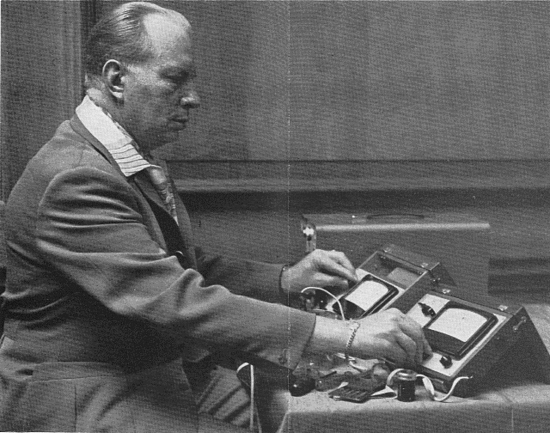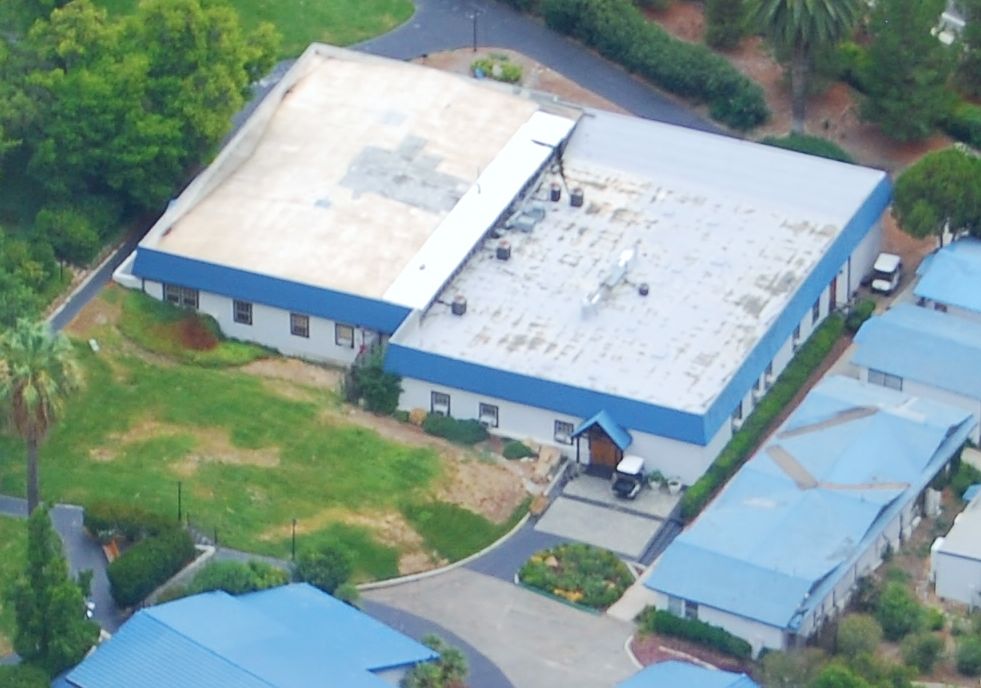So there was this Nebraska cornhusker, L. Ron Hubbard, who convinced some people that he had unlocked the mysteries of the universe as no one had ever done before or since…
Hubbard claimed to have created an exact science which would allow you to travel back millions, billions, even trillions of years into your past to see what your immortal self — which he called a “thetan” — had experienced in past lives on countless other planets.
Before he unlocked the secrets of immortality and past-life time travel, Hubbard had been a prolific science fiction writer and inventor of tall tales. But as he grew his movement of “Scientology” through the 1950s and 1960s, his followers were less interested in his past than the elaborate bureaucratic structure he was creating for his movement.
From 1967 to 1975, Hubbard ran Scientology from a small armada of ships sailing the Mediterranean and the Atlantic, and named himself its “Commodore.” During that time, he developed the highest of Scientology’s many (increasingly expensive) gradients, called the “Operating Thetan” levels, OT1 to OT8. (OT3 tends to get the most attention.) In general terms, the higher you can go in this training, the farther back into your past you can explore.
That time at sea gave rise to Scientology’s “Sea Organization” — made up of the most hardcore members, who sign billion-year contracts and work for little pay and with little privacy and almost no time off.
While Scientologists told each other that Hubbard’s “technology” was an exact, infallible science, to the outside world, they insisted that their movement was a religious organization and deserved the protections and tax-exempt status of a church.
With secrets like the pricey OT levels to protect, and with governments launching investigations of Scientology around the world, Hubbard increasingly turned to methods of control, including frequent interrogations of his followers with the use of his “e-meters” — interrogations which they have to pay for.
Weary of operating from sea, and worried about what the US government had in its files about him, in 1973 Hubbard and his wife Mary Sue began an audacious scheme to infiltrate federal offices and steal documents with information about Scientology. Dubbed “Operation Snow White,” the thefts resulted in a 1977 FBI raid of church offices in Washington DC and Los Angeles.
The FBI raids also uncovered Scientology documents which showed that for years, the church had tried to frame author Paulette Cooper, who had written one of the first book-length exposes of Hubbard and his organization, 1971’s The Scandal of Scientology. At one point, Cooper was facing 15 years in a federal prison on fake evidence produced by the church. Many other journalists and critics of the church have been followed and harassed in the years since.
Mary Sue Hubbard was one of 11 members of her “Guardian’s Office” who were prosecuted as a result of Operation Snow White. L. Ron Hubbard was named an unindicted co-conspirator, but was spared prosecution. The Guardian’s Office was abandoned and replaced with the Office of Special Affairs, which oversees the church’s covert operations today. In 1980, fearing tax agents or the FBI, Hubbard went into hiding with a young couple named Pat and Annie Broeker. He appeared to name them this successors, and they were with him when he died on January 24, 1986. A few days later, Pat Broeker was one of those who announced that Hubbard had voluntarily left his body to pursue his research elsewhere in the galaxy.
The Broekers, however, lost a power struggle with a young Scientology executive named David Miscavige, who also spoke at the announcement of Hubbard’s death at the Hollywood Palladium.
In the 26 years since, Miscavige has led Scientology as its absolute ruler, very carefully crafting his public appearances at church events, and always with a message that Scientology is expanding at unprecedented rates. (It isn’t.)
In recent years, Miscavige has faced one crisis after another as Scientology’s layers of control, obsession with celebrities, and reliance on Hubbard’s preference to attack the church’s perceived enemies have backfired on him.
Throughout its history, Scientology has experienced controversies, press exposes, and government investigations. But then, in 2008, it ran into Anonymous. When the church tried to suppress a YouTube video of Tom Cruise talking about Scientology, the Internet struck back.
There have always been defections from Scientology, but from 2004 to 2007, several high-level executives left the church, and then in 2009 participated in “The Truth Rundown,” a devastating series in the St. Petersburg Times that was followed up by CNN’s Anderson Cooper. Miscavige was portrayed as more violent sociopath than religious leader.
For playing his part in “The Truth Rundown” and for starting a blog criticizing the church, former executive Marty Rathbun was besieged last year in his South Texas home by a bizarre intimidation squad of Scientologists who called themselves “Squirrel Busters.” For five months they surveilled him everywhere he went, and were told to “make Marty’s life a living hell.”
Other executives who spoke out in “The Truth Rundown” were also followed by church operatives, and found themselves the subject of slimy anonymous websites (which the church later admitted a connection to).
More shocking revelations were coming not from former high-level executives, but people who had grown up in the church. Telling their stories at the website Ex-Scientology Kids, Jenna Miscavige Hill (niece to David Miscavige), Astra Woodcraft, and others told tales of growing up in a church that believes children are just little grownups with ancient souls.
At the beginning of 2012, former church executive Debbie Cook sent a mass e-mail to Scientologists complaining of Miscavige’s leadership. The church sued her over it, and under oath in a Texas court she testified to the horrifying conditions at “The Hole,” a prison for Scientology executives at the church’s international base east of Los Angeles.
While more former church members and officials were speaking out, Scientology’s longtime strategy of using celebrities as fronts started to turn into a liability. Every time John Travolta, formerly a shining light for the church, was hit with another accusation that he’d inappropriately touched a male masseur, news stories would tend to remind readers that Scientology has a long history of homophobia.
Then, eight days at the end of June and early July began what turned into the most disastrous summer for Scientology in decades. First, news broke of two stunning escapes from the International Base in the California desert: Roanne Horwich, a granddaughter to L. Ron Hubbard who had spent almost her entire life on the base, and Ron Miscavige Sr. (pictured), father to the leader of the church.
The same day that news broke, a bigger story exploded: Katie Holmes had filed for divorce from Tom Cruise, and the way she did it — asking for full custody, filing in New York while Tom was out of town, and with clockwork precision — suggested that she wanted to get her daughter Suri away from Scientology.
A few days later, another stunning development in the growing “independent Scientology” movement as more and more longtime members flee Miscavige’s leadership. In Israel, an entire mission in Haifa led by Dani and Tami Lemberger declared itself no longer to be a part of the church. The Lembergers were immediately excommunicated.
The day before that was reported, another bombshell: Alexander Jentzsch, the 27-year-old son of Scientology’s president, Heber Jentzsch, had been found dead in his in-laws’ Los Angeles home. Toxicology reports later showed that he’d used methadone while suffering from pneumonia, which proved a lethal combination.
Jentzsch’s death was an embarrassing reminder of Scientology’s toxic policy of “disconnection.” Alexander’s father Heber had been one of the executives held for years in “The Hole” at Int Base. When his ex-wife and the mother of Alexander, Karen de la Carriere, complained about Heber’s confinement, she was excommunicated, and Alex was forced to shun her. Cut off from both of his parents, he could turn to neither when he needed help in the days before his death.
All of that — news of the defection of Miscavige’s father, the Cruise-Holmes split, the Haifa defection, and Alex Jentzsch’s death — broke in just eight days. Media coverage following those events caused intense scrutiny of other Scientology controversies. One question that got asked a lot this summer: What happened to Shelly?
David Miscavige’s wife Shelly was once a high-ranking executive in her own right in the church. But after attending her father’s funeral in August 2007, she hasn’t been seen by other church members. Reportedly, she had angered her husband about some hiring decisions, and she was, at least until 2010, being kept out of view at a Scientology compound in the mountains above Los Angeles. Where is she today? A church attorney says she isn’t “missing.” But why hasn’t she been seen by any of her fellow church members?
Last month, another shock: Vanity Fair reveals that in 2004, Scientologist actress Nazanin Boniadi was “auditioned” by Shelly Miscavige (who had not yet disappeared) to be Tom Cruise’s next girlfriend after his breakup with Penelope Cruz. Three months later, Cruise reportedly cast Boniadi aside after asking to have her incisors filed down.
This guy made a movie.
2012 has also been disastrous for Scientology’s drug rehab program, Narconon. Health officials closed down the Quebec facility in April. In July, the third patient death in nine months happened at Narconon’s flagship facility in Oklahoma, triggering multiple local and state investigations. Government officials there seem determined to shut the place down.
In recent weeks, the crises just seem to be coming even faster. Another young second-generation Scientologist, Sons of Anarchy actor Johnny Lewis, had some kind of freakout, murdered his 81-year-old landlady and ripped apart her cat before either falling from or jumping off of her roof, which killed him. Battling his own addictions, Lewis had promoted Narconon in the past.
Another nightmare for Narconon is unfolding in the Atlanta area, where the media there is exposing the deceptions and half-truths of Narconon Georgia, which may have led to the 2008 death of a patient named Patrick Desmond (pictured). Why, the media seems determined to find out, is a place that regularly lies to drug courts and desperate parents allowed to operate?
And maybe the most bizarre revelation yet: two former church private investigators filed a lawsuit against David Miscavige and Scientology after their payments were stopped. For 24 years, they allege, the church had spent between $10 and $12 million so that the investigators could secretly keep tabs on one man: Miscavige’s old rival for power, Pat Broeker.
And that’s where we are today. We can hardly wait to see what happens tomorrow.






































